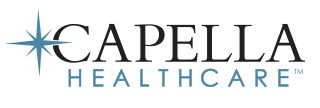Capella’s hospitals realizing benefits of Electronic Health Records
Electronic health records (EHRs) can provide many benefits for providers and their patients. Capella Healthcare’s family of hospitals is now in position to realize those benefits, having completed stage one of an enterprise-wide conversion process that upgraded information systems to better support caregivers in providing the highest quality of care.
The company embarked on this clinical journey with MEDITECH 6.0 as its core tool in 2011. The first step in this journey – bringing the majority of Capella’s facilities live on MEDITECH 6.0 as the go forward IT platform – was completed in 2013. (The company’s other hospitals are using an HMS platform.)
“We are all very grateful for the thousands of physicians and employees who had to learn a new way of doing things, even as they continued providing outstanding care to patients. Our successful conversion was the result of tremendous teamwork.
-Al Smith, Senior Vice President, Chief Information Officer
This effort included a replacement of all the functionality that was supplied via MEDITECH Magic or 5.64 and Pro Med (ED/ER system), as well as new functionality and technology including:
- Inpatient Computerized Physician Order Entry (CPOE)
- Zynx evidence-based order set content
- ED/ER Centralized Provider Order Entry (CPOE)
- ED/ER On-line Physician Documentation
- Internet based training modules
- Network and device refresh and additions
- New faxing solution
- New down time solution
- New remote access solution
- DRAGON voice recognition in the ED/ER

Connie Pullen, CNO & Project Sponsor
Willamette Valley Medical Center (WVMC) was the first of Capella’s hospitals to convert. “It’s making a tremendous difference in our world, said Connie Pullen, Chief Nursing Officer and Project Sponsor. “There’s a lot of seamless automation in this. As physicians come out of school and join us, this is what they expect. It’s state of the art. The investment at WVMC alone cost more than $3.5 million.
Dr. David Siepmann, a radiologist at WVMC, chaired the Physician Advisory Group, which provides overall guidance for the implementation of new IT initiatives. “Computer systems have the potential to significantly improve the way we take care of patients. The can help us prevent errors, access vast stores of information quickly and help coordinate care between providers. They can help us prevent errors, access vast stores of information quickly and help coordinate care between providers.
Capella’s President and CEO Michael Wiechart was very pleased with the accomplishments of the team. “These past two years were critical years for the company to achieve IT objectives that will enhance our quality initiatives through information technology, he said Michael Wiechart. “Additionally, achieving these objectives led to the receipt of additional payments that will significantly benefit each hospitals’ financial health. Through the second half of 2012 and first half of 2013, the company successfully converted eight hospitals to an enterprise-wide ‘design and build’ model of MEDITECH 6.0 which, based on our best knowledge, is the only conversion done this way in the country. Because of this collaborative and creative approach, our hospitals were able to deploy a high quality IT system at a fraction of what stand-alone organizations would have had to pay. As a result, all of Capella’s hospitals were able to successfully attest for Meaningful Use Stage 1 on time and below budget.
What’s Next?
Now that this first step in the journey is complete, staff is working together to enhance the system further to:
- Hardwire clinical documentation
- Increase efficiencies in the clinical documentation and ancillary department work flows
- Incorporate non-ED/ER physician documentation
- Add additional specialty areas (e.g., OB, general surgery, orthopedics) for increased CPOE
- Add mobile phlebotomy tool
- Add ePrescribing (required for MU Stage 2)
- Launch patient portals (required for MU Stage 2).
“While our aggressive schedule was predicated on meeting the government-mandated dates to comply with Meaningful Use Stage 1, our goal is certainly much broader overall, said Al Smith, SVP, Chief Information Officer, who led the conversion process. “What we’ve achieved is establishing an information systems foundation that better supports our caregivers and engages our physicians in reducing variability to provide the highest quality and safest experience in our hospitals. We want to express our appreciation to each facility’s Project Sponsor, the IS departments, facility department managers/directors, and facility super users who play a huge role in the success of any project such as this. Additionally, we are all very grateful for the thousands of physicians and employees who had to learn a new way of doing things, even as they continued providing outstanding care to patients. Our successful conversion was the result of tremendous teamwork.
What is Meaningful Use?
Realizing the benefits of electronic health records depends on how effectively they’re used. The phrase “Meaningful Use – a part of the American Reinvestment and Recovery Act (ARRA) – is the set of standards defined by the Centers for Medicare & Medicaid Services (CMS) Incentive Programs that governs the use of electronic health records (EHRs) and allows eligible providers and hospitals to earn incentive payments by meeting specific criteria. The goal of the program is to promote the spread of electronic health records to improve health care in the United States.
The benefits of the meaningful use of EHRs include:
- Complete and accurate information. With electronic health records, providers have the information they need to provide the best possible care. Providers will know more about their patients and their health history before they walk into the examination room.
- Better access to information. Electronic health records facilitate greater access to the information providers need to diagnose health problems earlier and improve the health outcomes of their patients. Electronic health records also allow information to be shared more easily among doctors’ offices, hospitals, and across health systems, leading to better coordination of care.
- Patient empowerment. Electronic health records will help empower patients to take a more active role in their health and in the health of their families. Patients can receive electronic copies of their medical records and share their health information securely over the Internet with their families.
One of the next stages of Capella’s full implementation of EHRs is introduction of a patient portal, in process for 2014.
New IT System Benefits Patients, Families and Hospital Staff
Editor’s Note: This article, written by Molly Walker, is reprinted with permission from the Yamhill Valley News-Register, which originally published it on August 31, 2012. Willamette Valley Medical Center (McMinnville, OR) served as Capella’s pilot hospital in launching the new Advanced Clinical Electronic System (ACES).
For families that have lived through the agony of watching a loved one wheeled into surgery behind closed doors, and having no idea who will emerge when with what kind of news, a revolution is under way at Willamette Valley Medical Center.
The hospital has just implemented a comprehensive new electronic recordkeeping system. And among its many ramifications, for patients and professionals alike, is the ability of relatives to monitor a surgery in progress.
The new system informs them when the surgery has begun and when it has ended. It informs them when the patient has been wheeled into recovery and when he or she will be returned to a regular room, ready to receive visitors.
After months of painstaking preparation, the multi-million-dollar system was launched in August.
CNO Connie Pullen, who has helped lead the way on implementation, said a family that recently took advantage of the new surgical monitoring component told her it made all the difference in the world. It made relatives feel closer to their loved one, more involved in their treatment and less fearful and anxious about the outcome. But she said that is just one of many beneficial aspects.
Pullen said nurses are excited because documentation of procedures has become far more automated, providing more precision with less investment of labor. She said that will allow them to put more time into patient care, which is what drew them to nursing in the first place.
Handouts about the conversion are being distributed to patients. They request patience while the process is being implemented, seek feedback along the way and promise big improvement in the end.
Pullen said key members of the line staff were involved in development of the new approach from the outset.
“You want the people who are at the beds every day developing the tools, she said.
And while more automation may be a good thing, too much may not. She said the hospital felt it was important to strike a balance between human and computer assessments.
There are many good reasons to automate health care records, Pullen said, but the one foremost is patient safety.
Under the new system, test results, treatment orders and drug orders flow directly from the physician’s fingertips to the lab, nurse and pharmacy in a process known as CPOE — Computerized Physicians Order Entry. Pullen said is one of the safest ways to convey directions without risk of introducing human error.
The new system has the same name as the old, Pullen said — Meditech. However, they are worlds apart.
The old system was designed using MS-DOS, and computer language used in early Microsoft computers. The new system is internet-based and functions completely differently.
Under the system, nurses learn of new orders for a patient the moment they are submitted. So do personnel in other departments, like radiology, helping everyone remain informed and coordinated.
“It’s making just a tremendous difference in our world, Pullen said. “There’s a lot of seamless automation in this.
“As physicians come out of school and join us, this is what they expect. It’s state of the art.
The conversion cost $3.7 million and involved every department in the hospital. Physicians have the same access as hospital personnel, even from home.
“All in all, we’ve trained over 700 people to use this system, Pullen said.
Registered nurse Amy Thompson, who divides her time between the birthing center and surgical suite, really appreciates the new system.
Each patient room has its own computer, complete with scanner and a small LED light above the keyboard. She said the light allows a nurse or doctor to access the system even when the patient is sleeping, without causing a disturbance.
She said the computer logs when vital signs were taken, when medications are next due, what rounds have been completed and what new orders have been introduced. It tracks virtually everything, she said, yet is very easy to use.
The installation is bringing the hospital up to the latest standards, Pullen said. With the use of initials on tracking boards located around the hospital, rather than full names, patient privacy is protected while efficiency is optimized, she said.
- Advanced Clinical Electronic System (ACES) Update
- Why Capella?
- Partnership with athenahealth
- Physician Leadership and Resources
- ACES (Advanced Clinical Electronic System) Training
- Practice Opportunities
- Community Profiles
- Contact Us
“Because of this collaborative and creative approach, our hospitals were able to deploy a high quality IT system at a fraction of what stand-alone organizations would have had to pay. As a result, all of Capella’s hospitals were able to successfully attest for Meaningful Use Stage 1 on time and below budget.
-Michael Wiechart,
President and CEO

